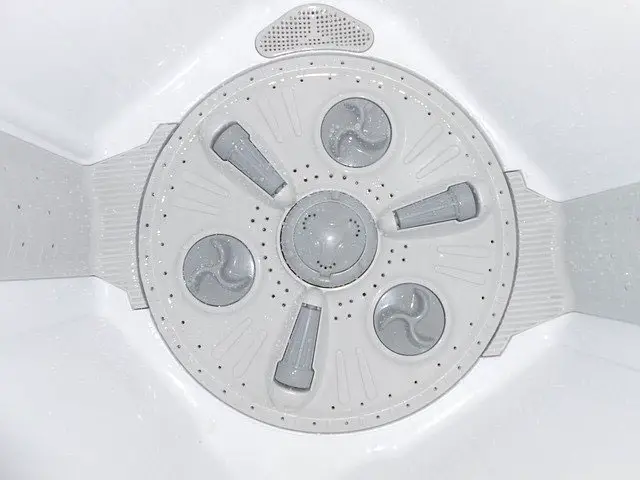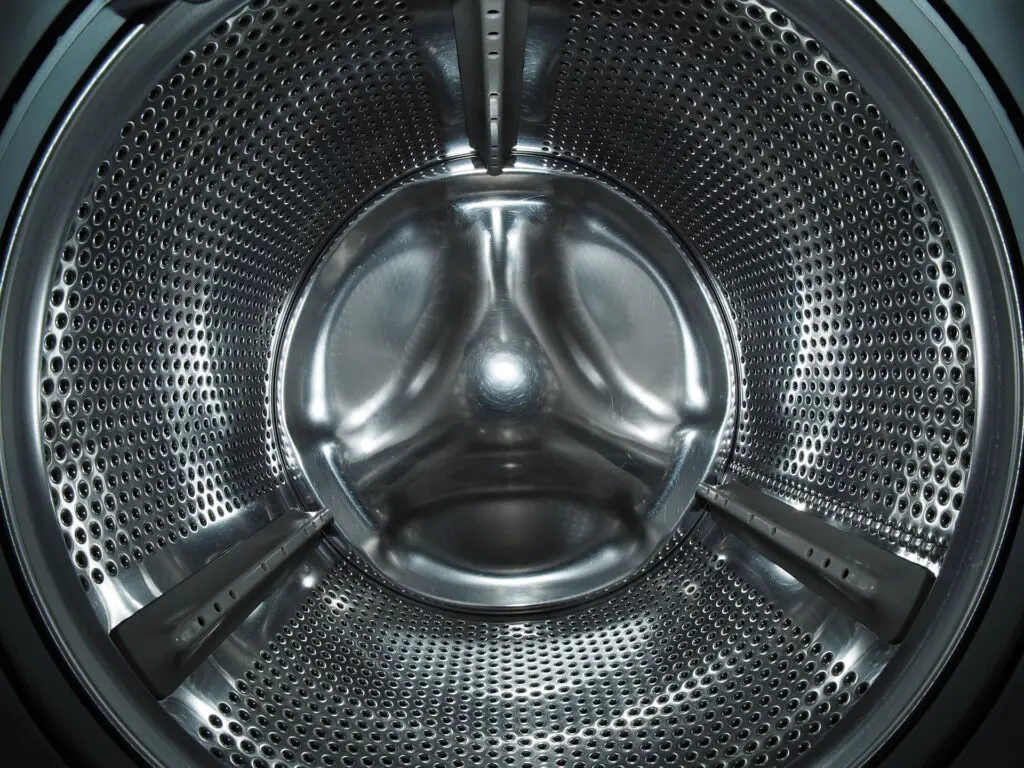Sometimes, putting laundry in the washing machine feels like putting it in a tambiolo of damage; when you pull out a batch, some will luckily be left in one piece, while some unlucky ones may have frays, holes, or missing buttons. Frustrated, you think to yourself: why does my washing machine damage my clothes – and how do I stop it?
This problem is actually two-pronged: while your washing machine can directly damage your clothes, the way you use your washing machine can also contribute to the problem.
Before digging in to the best laundry practices to preserve the quality of your clothes, we should do a quick rundown of how a washing machine works, and how it can damage your clothes.
How washing machines damage clothes
To clean your dirty clothes, washing machines use rotational force to move clothes through soapy water. A washing machine uses different parts for this, and sometimes those parts may be the ones that are causing the damage to your clothes. Here is a list of the most common damages done by washing machines with their most probable machine-related causes:
1. Problem: Rips
Probable cause: Clothes got caught under the base of the agitator/pulsator

For top-loading washing machines, the agitator (or pulsator) is the spinning part that produces the rotational force in the water. Sometimes clothes can get caught under the seemingly narrow space if the agitator is not bolted down properly. When snagged, these clothes can get ripped apart by the rotational force of the water or during spin drying.
Solution:
When removing stuck clothes, don’t use brute force as this will surely end with a ruined outfit. Instead, remove the screws from the agitator and just pull it off the drum. Make sure to screw it back properly after your retrieve your clothes.
Also, the forces inside the washing machine can exacerbate existing tears on your clothes. To protect your clothes, you should patch up any existing damage first before putting it through a washing and drying course.
2. Problem: Frays
Probable cause #1: Clothes being pushed through the drum holes

A washing machine’s inner drum has holes on its body to allow water to come in from the static outer drum during the wash cycle. During spin drying, these holes serve as the exit point of the water that is wrung out of the clothes.
However, with spin speeds reaching up to 1,400 rpm, the centrifugal force generated by the spinning drum will force your clothes to go through the holes. This can loosen the weaves especially on clothes of lower quality. Additionally, if the holes have particularly sharp edges, it can rip and tear clothes that get caught in the holes during spinning.
Solution: Limiting the use of spin drying
Since the drum holes are an integral part of the washing and drying process, the solutions to this problem are limited
For one, you can limit the use of the spin dryer and opting for hanging and air drying instead. If you are going to use it, opt for a slower speed.
The best way to prevent this from happening is by choosing a washing machine model with unique features that offer protection for your clothes. Look at Sharp’s No-Holes Tub feature or Samsung’s Diamond Drum feature.
FURTHER READING: Washing Machine Buying Guide
3. Black spots on clothes
Probable cause: Black mold growth in your washing machine.
Molds grow best in a damp and dark environment – the interior of a washing machine is one good example of that. Not only do these small black microbes soil your clothes, it also imparts a dank moldy smell to your batch of laundry.
Solution: Clean your drum
To solve your mold problem, run a regular cycle with hot water and a cleaning solution (Not soap! Bleach or a vinegar-baking soda solution will do) to clean the molds off of the drums.
The most mold-prone areas are the outer drum and the outer side of the inner drum. This is usually the case if the drums are left wet for a period of time. To prevent this, you should keep the lid open after using to ventilate the interior of the washing machine. You should also remove the wet clothes immediately and give the tub a good wipe down afterwards.
Note:
Most fully automatic washing machines have a tub clean function. Use it at least once every 20 washes.
P.S. don’t put laundry in the washing machine when using the tub clean function – it can ruin your clothes!
4. Problem: Holes
Probable cause: Drum damage caused by a sharp object
If you don’t remove sharp objects like keys, coins, and even bra wires, it may damage the washing machines drum wall. This will create rough spots and sharp edges where your clothing can get snagged and torn.
Solution: Either filing down the sharp edges or replacing the drum Nope, it’s PREVENTION.
If you suspect that this is the case, grab a flash light and inspect the drum wall for any damages. You should also use your hands to feel for the rough spots and sharp edges – and if you do, you are unfortunately at a crossroad.
See, the best answer for this is ‘prevention is better than cure’ as the fixes for this may be impractical. If your unit is still covered by warranty, then good – ask your brand’s technician for possible fixes or replacement parts. But for those that aren’t? Well…contemplate this:
Filing down the sharp edges will ruin the protective coating of the drum, corroding it over time (see #5). Meanwhile, replacing the drum itself can be impractical especially if the parts + labor costs more than half of what you bought your unit for.
5. Rust spots on clothes
Probable cause: Damaged drum or a foreign metal object.
Rust stains are one of the hardest to remove from clothes.
While most fully automatic washing machines are equipped with rust-resistant stainless steel drums, they can still rust from the inside – especially when the drum is damaged in any way.
If you don’t see any damage on your drum, then it may be a foreign metal object (it could be a coin, a key, or a rouge bra wire) stuck somewhere inside your washing machine. One of the most common places that these things can get stuck on is under the pulsator or agitator – remove it ASAP!
Solution: Rust removal
The solution is surprisingly simple: fill up your washing machine with water, add two cups of vinegar and then run it through a regular wash cycle. Repeat the process, but now add baking soda to the mix to give your drum a good rinsing.
Bonus: if the problem persists, it may not be the washing machine itself – it could be the water pipes. There is nothing more you can do here but to call a plumber to replace your pipes.
How to keep your washing machine from damaging your clothes
Follow these tips to reduce the damage your washing machine will do to your clothes.
1. Follow the care instructions on your clothes
While most clothes can be washed in the washing machine with no problems, it doesn’t hurt to check the care labels first before tossing them in.
Some fabrics shrink when washed in warm water or heat-dried; some fabrics should not be spin-dried; and some (like lace and silk) shouldn’t go in the washing machine altogether.
2. Do not overload your washer
We’ve all done this at one point (who wants to do yet another batch of laundry anyway?), but doing this will damage our appliance and our clothes.
Not only will the extra weight put an extra burden on your washer’s bearings and motor, it can damage clothes as well.
When clothes are jam-packed and have no where else to go, they can lodge themselves in less than ideal spaces like under the agitator (recall problem #1 above) or between the door seal (for front loaders). This may cause tears or a totally ruined outfit if you’re really unlucky.
3. Zip up and button up clothes

If the buttons are unfastened and the zipper’s teeth and slider are hanging loose, they can snag your clothes and rip them. Not only will you lose some buttons on your clothes, what’s more is that these can damage the drum itself, which will result to more damage to your clothes (recall problem #4 above).
4. Avoid the dryer when possible
This goes for both spin dryers and heat dryers.
As stated earlier, the rotation force during spin drying can cause clothes to go through the drum holes, pulling the weave apart. Also, some clothes just aren’t suited to be put on a hot drying cycle as they can shrink or loosen.
The best alternative will be to hang your clothes to air dry. But if you’re in a pinch, go ahead with spin drying.
5. Use a mesh bag for delicates
A wire mesh bag protects your delicate items from damage during the wash cycle. You should also put any article of clothing with velcro inside of a mesh bag before washing; the velcro can latch on to other clothing which can damage them while they spin.
Conclusion
Chucking clothes in the washer may seem like a straight-forward thing to do (after all, why buy a washing machine if not for convenience?), however, observing best laundry practices will save your clothes (and your washing machine) from damage.

Miguel Mores worked for 5 years as a member of the product management team for a home appliance company in the Philippines. He started 101appliance to answer the most common customer questions that he has encountered during his time in the industry. He now works in the digital marketing field and manages a small online bookstore on the side.


